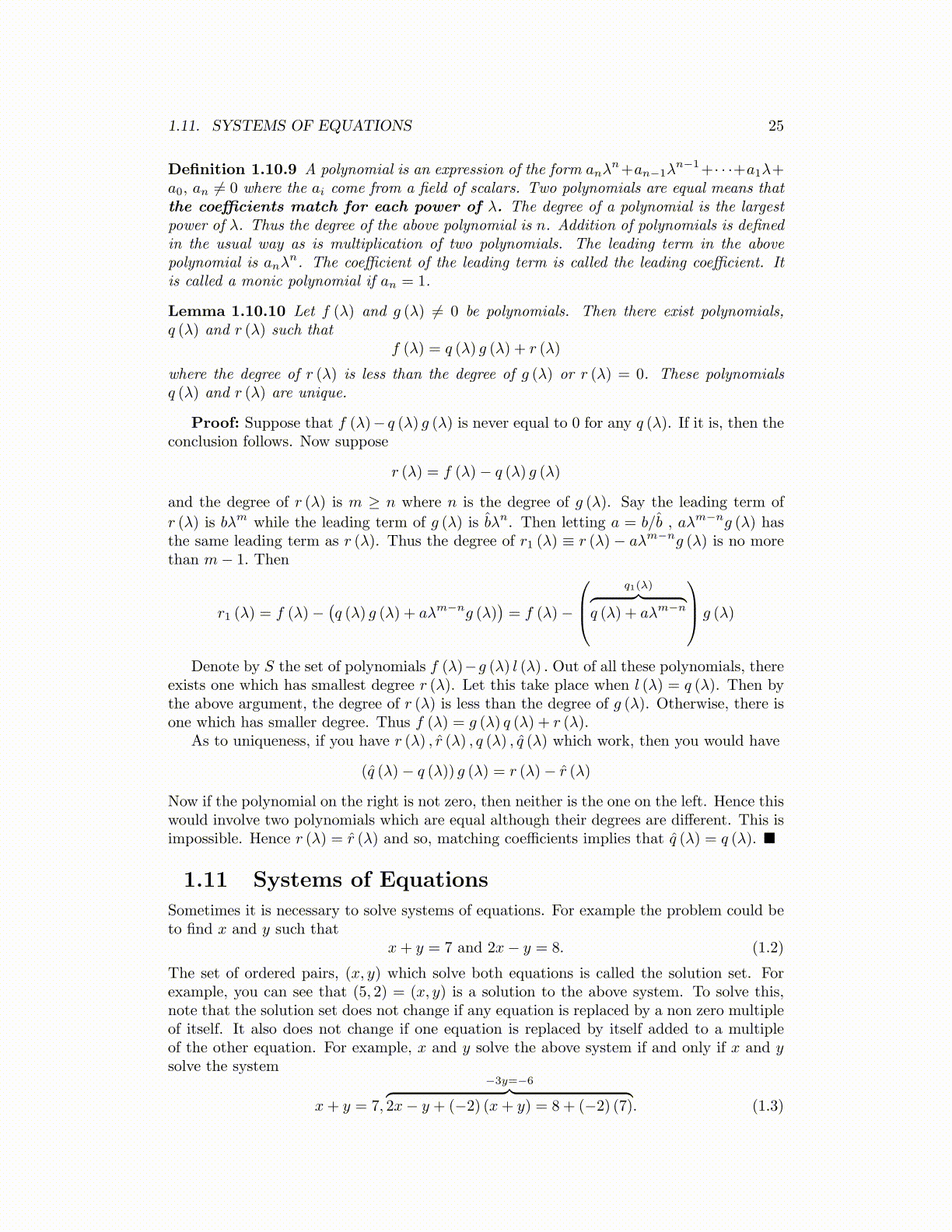
1.11. SYSTEMS OF EQUATIONS 25
Definition 1.10.9 A polynomial is an expression of the form anλn+an−1λ
n−1+· · ·+a1λ+a0, an ̸= 0 where the ai come from a field of scalars. Two polynomials are equal means thatthe coefficients match for each power of λ. The degree of a polynomial is the largestpower of λ. Thus the degree of the above polynomial is n. Addition of polynomials is definedin the usual way as is multiplication of two polynomials. The leading term in the abovepolynomial is anλ
n. The coefficient of the leading term is called the leading coefficient. Itis called a monic polynomial if an = 1.
Lemma 1.10.10 Let f (λ) and g (λ) ̸= 0 be polynomials. Then there exist polynomials,q (λ) and r (λ) such that
f (λ) = q (λ) g (λ) + r (λ)
where the degree of r (λ) is less than the degree of g (λ) or r (λ) = 0. These polynomialsq (λ) and r (λ) are unique.
Proof: Suppose that f (λ)− q (λ) g (λ) is never equal to 0 for any q (λ). If it is, then theconclusion follows. Now suppose
r (λ) = f (λ)− q (λ) g (λ)
and the degree of r (λ) is m ≥ n where n is the degree of g (λ). Say the leading term of
r (λ) is bλm while the leading term of g (λ) is b̂λn. Then letting a = b/b̂ , aλm−ng (λ) hasthe same leading term as r (λ). Thus the degree of r1 (λ) ≡ r (λ)− aλm−ng (λ) is no morethan m− 1. Then
r1 (λ) = f (λ)−(q (λ) g (λ) + aλm−ng (λ)
)= f (λ)−
q1(λ)︷ ︸︸ ︷
q (λ) + aλm−n
g (λ)
Denote by S the set of polynomials f (λ)−g (λ) l (λ) . Out of all these polynomials, thereexists one which has smallest degree r (λ). Let this take place when l (λ) = q (λ). Then bythe above argument, the degree of r (λ) is less than the degree of g (λ). Otherwise, there isone which has smaller degree. Thus f (λ) = g (λ) q (λ) + r (λ).
As to uniqueness, if you have r (λ) , r̂ (λ) , q (λ) , q̂ (λ) which work, then you would have
(q̂ (λ)− q (λ)) g (λ) = r (λ)− r̂ (λ)
Now if the polynomial on the right is not zero, then neither is the one on the left. Hence thiswould involve two polynomials which are equal although their degrees are different. This isimpossible. Hence r (λ) = r̂ (λ) and so, matching coefficients implies that q̂ (λ) = q (λ). ■
1.11 Systems of Equations
Sometimes it is necessary to solve systems of equations. For example the problem could beto find x and y such that
x+ y = 7 and 2x− y = 8. (1.2)
The set of ordered pairs, (x, y) which solve both equations is called the solution set. Forexample, you can see that (5, 2) = (x, y) is a solution to the above system. To solve this,note that the solution set does not change if any equation is replaced by a non zero multipleof itself. It also does not change if one equation is replaced by itself added to a multipleof the other equation. For example, x and y solve the above system if and only if x and ysolve the system
x+ y = 7,
−3y=−6︷ ︸︸ ︷2x− y + (−2) (x+ y) = 8 + (−2) (7). (1.3)